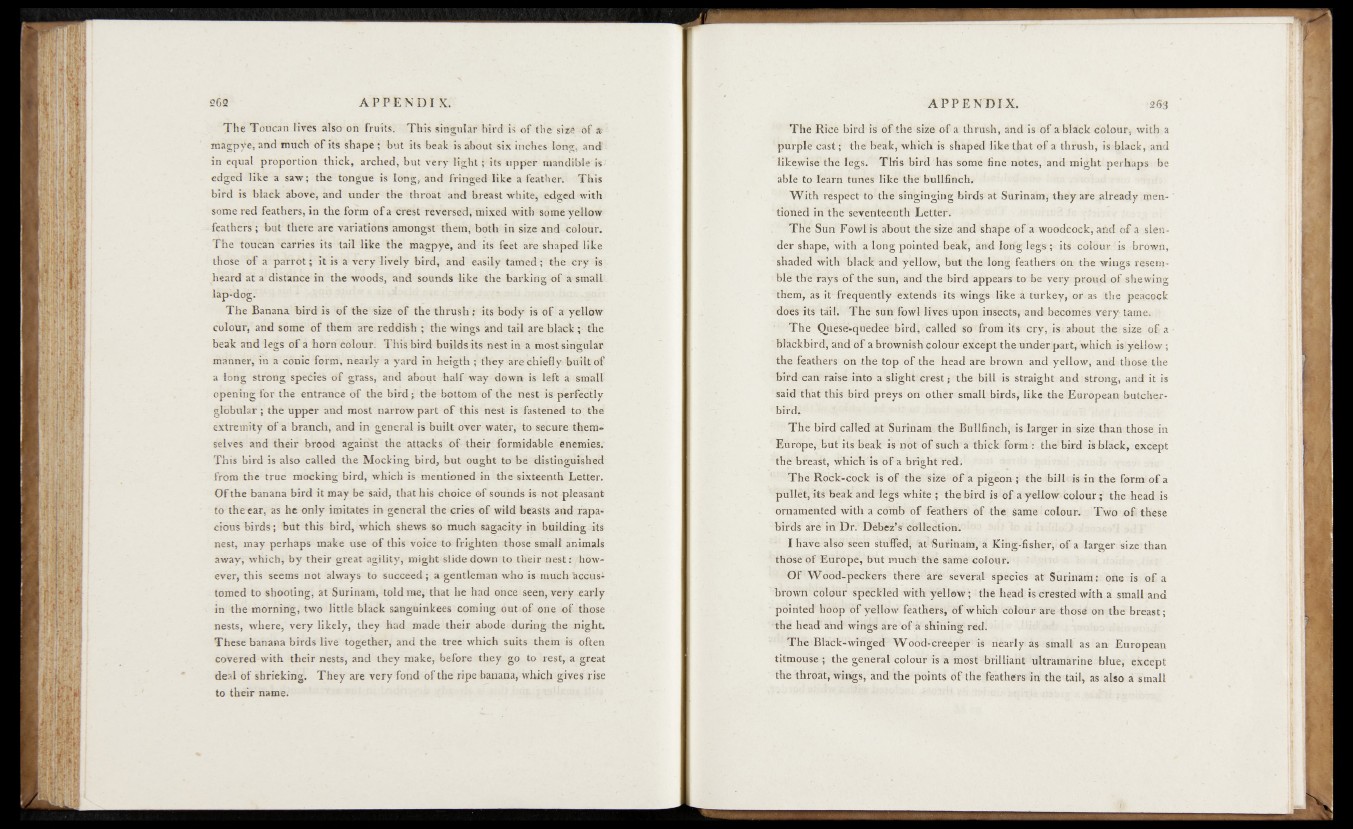
The Toucan lives also on fruits. This singular bird is o f the size -of *
raagpye, and much o f its shape ; but its beak k about six inches 1on«-, and
in equal proportion thick, arched, but very lig h t; its upper mandible is-
edged like a saw; the tongue is long, and fringed like a feather. This
bird is black above, and under the throat and breast white, edged with
some red feathers, in the form o f a crest reversed, mixed with some yellow
feathers; but there are variations amongst them, both in size and colour.
The toucan carries its tail like the magpye, and its feet are shaped like
those o f a parrCt; it is a very lively bird, and easily tamed; the cry k
heard at a distance in the woods, and sounds like the barking o f a small
lap-dog.
The Banana bird is of the size o f the thrush : its body is of a yellow
colour, and some of them are reddish ; the wings and tail are black ; the
beak and legs o f a horn colour. This bird builds its nest in a most singular
manner, in a conic form, nearly a yard in heigth ; they are chiefly built of
a long strong species o f grass, and about half way down is left a small
opening for the entrance of the bird j the bottom of the nest is perfectly
globular; the upper and most marrow part of this nest- is fastened to the
extremity of a branch, and in general is built over water, to secure themselves
and their brood against the attacks o f their formidable enemies.
This bird is also called the Mocking bird, but ought to be distinguished
from the true mocking bird, which is mentioned in the sixteenth Letter.
Of the banana bird it may be said, that hk choice of sounds is not -pleasant
to the ear, as he only imitates in general the cries o f wild beasts and rapacious
birds ; but this bird, which shews so much sagacity in building JtS
nest, may perhaps make use of this voice to frighten those small animals
away, which, by their great agility, might slide down to their nest; . however,
this seems not always to succeed; a gentleman who is much focus1
tomed to shooting, at Surinam, told me, that he had once seen, very early
in the morning, two little black sanguinkees coming out.of one o f those
nests, where, very likely, they had made their abode during the night.
These banana birds live together, and the tree which suits them is often
covered with their nests, and they make, before they go to rest, a great
deal of shrieking. They are very fond of the ripe banana, which gives rise
to their name.
The Rice bird is of the size of a thrush, and is of a black colour, with a
purple cast; the beak, which is shaped like that of a thrush, is black, and
likewise tfié fogs. This bird has some fine notes, and might perhaps be
able to learn tunes like thé bullfinch.
With résp'ëct tó the singinging birds at Surinam, they are already men-
;turned in'the seventeenth Letter.
Thé Sun Fowl is about the size and shape of a woodcock, and o f a slender
shape, with a long pointed beak, and Iorig legs ; its colbur is brown,
shaded with black and yellow, but the long feathers on the wings resemble
the rays of the sun, and the bird appears to be very proud of shewing
them, as it frequently extends its wings, like a turkey, or as the peacock
does its tail. The sun fowl lives upon insects, and becomes very tame. >
■ The Quese-quedee bird, called so from its cry, is about the size o f a
blackbird, and of a brownish colour except the under part, which is yellow ;
the feathers on the top o f the head are brown and yellow, and those the
bird can raise into a slight crest j the bill is straight and strong, add it is
said that this bird preys on other small birds, like the European butcherbirds
x -
The bird called at Surinam the Bullfinch, is larger in size than those in
Europe, but its beak is nbt o f such a thick form: the bird is black, except
thébfeaèt, which is o f a bright red.
The Rock-cock is of the size o f a pigeon; the bill ok in the form o f a
pullet, its beak and legs whife^ the bird is o f a yellow colour - the head is
ornamented with a comb of feathers of the same -colour. Two o f these
birds are in Dr. Debez’s collection.
I havoalsö seen stuffed; at1 Surinam,! a Kihg-fisher,iof a larger size than
those bf Europe, but much1 the same colour.
Of Wood-peckers there are several species at Surinam: one is o f a
brown colour speckled with y ellow; the head is crested w/th a small and
pbinted lio öp ó f yè'llöw feathèirsv öf which colour are those on the breast;
thé headand wings are'of [si shining red.
The Black-winged Wood-ereeper is nearly as small as an European
titmouse ; the general colour is a móst brilliaiit 'ultramarine blue, except
the throat, wings, and the points öf the feathers in the tail, as also a small